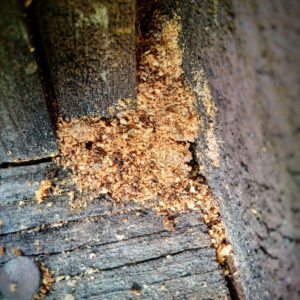DO TERMITES LEAVE SAWDUST PILES BEHIND?
By Chris Williams on May 17, 2019.
We’ve found a few small piles of what seems to be sawdust on the tile floor at the base of wood paneling on our family room wall. Does that mean we have termites infesting the paneling or feeding inside the walls?
E. H., Epsom, NH
I would say you almost certainly don’t have termites in the paneling, or at least it is not termites that are leaving the sawdust piles. I always emphasize the importance of a professional inspection in cases like these since a number of different things could be going on.
To put your mind at ease, our subterranean termites do not produce sawdust. The reason is that they feed on the wood that they are tunneling through so there is no loose wood or sawdust left behind and what comes out the other end of a termite is a mud-like material instead (see Could This Be Termite Damage?).
SAWDUST MAY BE DIGESTED WOOD PELLETS

Fecal pellets from wood boring beetles. Z. Ciras
Insects produce sawdust when they are simply tunneling through the wood, carpenter ants for example, or when wood-boring beetle larvae are infesting wood and expel fecal droppings after ingesting wood. Those droppings are very tiny, wood-colored pellets, and are actually finer than sawdust. They are found in a small pile beneath beetle exit holes in infested wood.
While our technicians will do a thorough inspection, looking for wood-boring pests or damaged wood, they will also analyze the contents of the sawdust pile (save some for identification). The type of wood being attacked, the age of the wood, and the presence of any beetle exit holes are other pieces of the puzzle.
WOOD-DAMAGING PESTS THAT DO LEAVE SAWDUST OF A SORT
1. Carpenter Ants –These large, black ants don’t eat wood, they tunnel through it to create galleries, shredding it with their jaws as they go. Because carpenter ants like clean, smooth nest galleries, they dump the excavated wood and any other debris out through cracks or slits in the wood. These “dump piles” also contain bits of sand, pieces of insulation or drywall (depending on where they are nesting), seed coats, dead carpenter ants, and the indigestible parts of their insect prey (see Are These Carpenter Ants?).
2. Powderpost Beetles –The larvae of these tiny dark beetles tunnel inside wood, filling their galleries with powdery frass or digested wood. There are three different groups of powderpost beetles and the frass for each group can often be identified by feel, ranging from powdery to gritty to mealy and sticky. These frass piles may look like sawdust until you put them under magnification. They do not contain debris or insect parts. Powderpost beetle frass is pushed out of exit holes when the adult beetles emerge and so is found on the wood or ground beneath the hole (see Is the Wood Damage From Powderpost Beetles?).
3. Old House Borers –The frass of these large wood-boring beetle larvae is made up of microscopic barrel-shaped pellets and has the consistency of cornmeal. These larvae and the larvae of other related wood borers invade wood before it is even used in construction, emerging years later in homes as beetles and leaving an oval exit hole in the process (see “Old House Borers” Infest New Houses).
When wood-infesting insects produce “sawdust” or frass during their life cycle, it is not always visible. Carpenter ant dump slits could open up into a wall void where the piles would never be seen. In the same manner, emerging beetles could exit into a void or on the backside of a piece of wood where spilled frass from their exit might not be noticeable.Since you’ve found sawdust piles, give Colonial Pest a call. Sometimes we find that the “sawdust” in question really is sawdust from construction or sawdust that has shaken loose from overhead joists or floor boards. Real sawdust won’t be powdery, or contain pellets or insect parts. Let our experts make the determination!